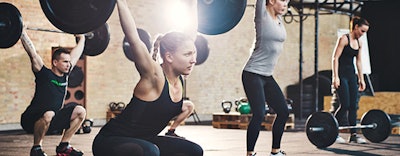
Free weight areas in most gyms have historically been loner zones. Beyond the occasional request for a spotter or instruction being delivered during a private coaching session, the primary soundtrack at the lifting platform and dumbbell station has been the clank of iron and the occasional grunt. However, with the advent of CrossFit and other such functional training regimens, strength training is suddenly in the spotlight, and an increasing number of people are learning to use free weights the right way within the context of a group exercise setting.
Joel Anderson is owner of Black Box Training in Queen, Ariz. He's just off a weekend of teaching a group weightlifting class for Eleiko, an equipment manufacturer that also provides programming. Anderson acknowledges that while sometimes considered fringe, the CrossFit movement has taken strength training mainstream. "I have to give massive props to CrossFit for making fitness cool again," he says. "The reality is that they're the ones that have propelled fitness in the last six years. I mean look at Olympic weightlifting, look at USA Weightlifting — the numbers are through the roof. Now we have to have multiple American Opens. It's just amazing, and you have to give CrossFit a lot of credit for all of that."

And while CrossFit has indeed proved popular for the community it has created based on the results it gets, the workouts and militant culture can sometimes be too intense for the average person. Without detracting from CrossFit, Anderson says he has definitely identified a population that still wants to pick up strength training basics with free weights but has been turned off by some elements of CrossFit. "I do see a little bit of the other direction, where some people come to me and say, 'Hey, my friend got hurt in CrossFit, I'm not sure I want to go that route,' or 'That looks really complicated, ' or 'I went one time for a free session and they wanted me doing cleans for a really long time, and I just didn't feel comfortable with that,' " Anderson says, adding that it's exactly these kinds of comments that have prompted more traditional gyms to expand space for free weights and provide strength training in a group setting.

Breaking it down
The courses Anderson teaches usually max out at 10 students per class. On occasion, there may be 16 students but four instructors present. The classes start by breaking down the fundamental weightlifting movements into basic positions, and the students will start this process without weights, usually using a PVC pipe or training bar. Most of the classes span a variety of ages and skill levels, but the methodology itself seems to pay dividends.
"It's amazing what happens when you break the complex movements into manageable pieces and you feed it to them one bite at a time," says Anderson. "We had an athlete who had never touched a barbell in his life and by the end of the weekend, he was looking really good. He was moving proficiently."
RELATED: Purchasing Guide: What you need to know when buying free weights
The classes typically follow a progression so that by the second day, students are using a regular Olympic bar without a load, and halfway through the second day, they're trying out the movements with weights. "You still need a manageable ratio of coaches to students, of course," Anderson says, "but it's a very proficient way of teaching from the power positions to the full snatch, in the sense that we generally will teach power cleans, power snatches, push jerks first. Then as they progress and have the ability to do weightlifting from the power positions, we'll work into full cleans, full snatches, if the mobility and the restrictions that each student has will allow it."
Anderson says participants learn even more in a group setting when they're asked to demonstrate a movement for other students. "Having a class of many different levels reinforces the learning curve," he says. "You find that as the environment opens up and people loosen up, they're giving each other pointers and helping each other out. It just reinforces the student learning the movement."

Strong culture
Bob Takano was inducted into the USA Weightlifting Hall of Fame in 2007 for his contributions to coaching. He has been the coach of four national champions, two national record holders and 27 top-10 nationally ranked lifters. He's been on the coaching staffs of 17 U.S. national teams at competitions, five of those being World Championships and the Summer Olympics. Put simply, he knows a thing or two about strength training, and he favors group training for a variety of reasons.
"A lot of people come in with the misconception that if they pay for a private session, they're going to get more out of it, and that's how private sessions have been marketed. But I've always felt that you get the most out of weightlifters training together," Takano says, noting that there are intangibles that come along with group training, especially when different skill levels are working together. "There's a number of things that happen. There's the passage of good information that takes place between a group of lifters, especially if you've got newcomers and veterans and they're training together," he says. "It can be something as little as where to get the best price on tape, or what's the best thing to eat and when's the best time to eat it. Just little insider things. As a coach, I'm not always up on the individual case of each athlete, but just athletes talking together can help pass along a lot of information."
RELATED: Product Spotlight 2018: Weight Rooms & Strength Equipment
Like Anderson, Takano thinks that athletes benefit greatly from being able to observe one another. "If you're trying to learn how to do snatches or clean and jerks, and you have nobody to watch, it makes it a lot more difficult to learn," he says. "If you have good mimicry skills, you can watch someone perform a movement and you can try to imitate that. And even though you might not get the movement completely right, you can pick up the timing."
Beyond the business of learning weightlifting skills, Takano says that the group training environment can instill an overall sense of commitment in the athletes. "The aspect of culture is an important one," he says. "There has to be a certain mindset that athletes have, and if they have not been athletes before, a lot of newcomers don't have that mindset. They don't know how to prioritize things in their life so they can have that lifestyle of an athlete. They're going to learn lifestyle most effectively from other athletes rather than me as the coach telling them how they should live their lives."
RELATED: Find more solutions for your facility in the Buyers Guide
It's no secret that a large majority of gym memberships go unused, primarily due to lack of motivation. Regardless of how one feels about CrossFit's philosophy, it's hard to argue that its adherents, as well as the gyms that offer the programming, benefit from the motivation and support inherent in a group setting. "I think they take an identity away from CrossFit. They feel like they belong to a group," Takano says. "Humans are social, and they're tribal, and because of that, if they find a group that they feel they belong to, they're more apt to continue on a regular basis. If somebody has a gym membership, they can show up any time, but being part of group is probably going to make them more diligent about showing up."
This article originally appeared in the October 2018 issue of Athletic Business with the title "Why more gyms should teach strength training in a group setting." Athletic Business is a free magazine for professionals in the athletic, fitness and recreation industry. Click here to subscribe.

































